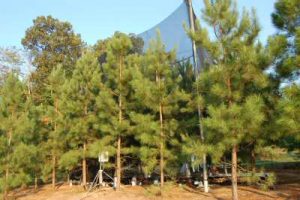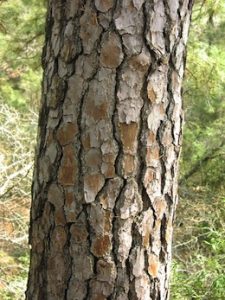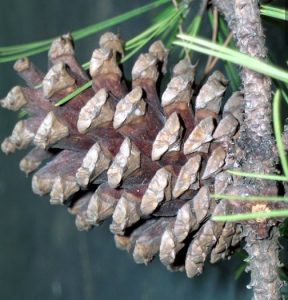Name That Tree
By Ray Novitske, Fairfax Master Gardener
 The correct answer is Loblolly Pine (Pinus taeda). This native is found throughout 12 southeastern states along the coastal plain (east of the mountains) from Delaware south to Florida and west to Texas, and is probably the most abundant pine species. It also has other names such as shortleaf pine, fox-tail pine and old-field pine.
The correct answer is Loblolly Pine (Pinus taeda). This native is found throughout 12 southeastern states along the coastal plain (east of the mountains) from Delaware south to Florida and west to Texas, and is probably the most abundant pine species. It also has other names such as shortleaf pine, fox-tail pine and old-field pine.
Its evergreen needles are six to nine inches long, and grow in clusters of three. This is one way to tell them apart from similar species like the Virginia Pine (Pinus virginiana) and Eastern White Pine (Pinus strobus). The Virginia Pine has clusters of two needles, and the Eastern White Pine has clusters of five.

male flower
Years ago, I heard that many people were unhappy with the multitude of loblolly pines in Reston planted when the town was built. Loblolly pines are everywhere because they provided the builders with instant screens and buffers because of their evergreen nature and fast growth. Now years later, another of their characteristics is not so desirable — the tendency to lose lower branches as the trees grow and mature. Once 10-20 feet of lower branches are gone, the trees no longer act as an effective screen.

bark
The tree loves sandy moist soils and can thrive in poor soils, hence it is most at home in poorly drained lowlands and wetlands. Because it grows with a straight trunk and is one of the fastest growing pines, it is an important crop, grown throughout the Southeast for lumber and pulp. These soils are quite sandy and often low in the nutrients required for hardwood growth or agricultural crops, so this type of land has no other profitable, alternative uses.

The term “loblolly” is an early American term for a wet depression, or muddy hole. Loblolly pines seed and grow up rapidly in abandoned fields and damp hollows, particularly in sandy soils where the water is close to the surface. It is also frequent in clumps along the borders of swamps and as scattered specimens in the swamp hardwood forests. It is known as a pioneer tree because it is one of the first trees to grow in cleared land, from past agricultural use or from fires — lending it the name “old-field pine.”
The Colonists boiled its resin into tar pitch to preserve wooden boats and ship riggings. Loblolly pines continue being useful today as an important building material … and as a landscape tree.
References
Loblolly Pine, Virginia Tech Dendrology
Common Forest Trees of Virginia, New River Notes
Study of Northern Virginia Ecology, Fairfax Public Schools
Loblolly Pine, Chesapeake Bay Program
Pinus taeda Loblolly Pine, Oklahoma Forestry Services
Pinus taeda, Missouri Botanical Garden